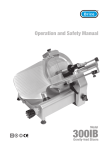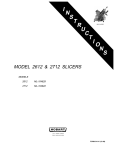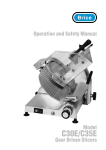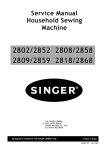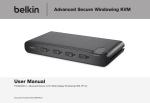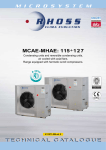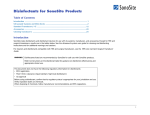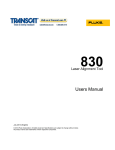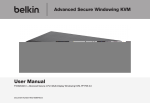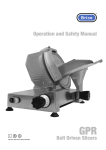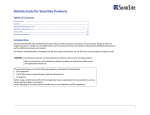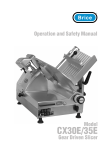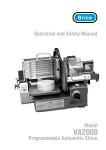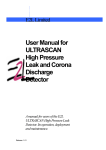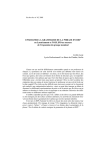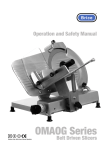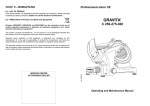Download user manual
Transcript
™ Operation and Safety Manual LVertical Series Slicers SAFETY ISSUES 1. Never touch this machine without training and authorisation from your supervisor. 2. Machine must be on solid, level bench/table. 3. Guards must be in place before plugging in and turning on machine. 4. Always use the three-pronged plug provided. 5. Never use your hand to hold food stuffs in place on the meat table. 6. Never touch the slicer blade when it is rotating. 7. Keep hands, arms, hair and loose clothing clear of all moving parts. 8. Should the slicer jam, SWITCH off and unplug before removing the obstruction. 9. SWITCH off and unplug the machine from its power source before cleaning, sanitizing or servicing. 10. Use only the attachments provided by the manufacturer and designed for this machine. YOUR SAFETY IS OUR PRIMARY CONCERN DEC LARAT I ON OF C ONF O RM I T Y Slicer Machine Model: Serial Number: Dated: is built in conformity with the provisions of: 98/37/C EE Machinery Directive E N 1974 Food processing machiner y - Slicing machines - Safety and hygiene requirements. EN 60204 Electrical equipment of industrial machines: Part 1 - General Design 89/109/CEE Directive for the materials and things destined to come into contact with food. 89/336/CEE Directive on Electromagnetic Compatibility (EMC) 73/23/EEC Directive on low voltage. Operation and Safety Manual Introduction ™ Overview This Operation and Safety Manual has been prepared to introduce you to the Brice L Series Vertical slicers (L25E, L30E. L35E and L37E). It explains the operation, cleaning and maintenance of the slicer in simple, clear terms and with an emphasis on your safety. Throughout the Manual procedures are supported by illustrations showing the parts involved and the recommended safe method of handling those parts. A word to the wise This Manual is really two sets of instructions in one - some sections are relevant to all Brice slicers, while other sections only concern a particular slicer or range of slicers. Make sure that you read this Manual carefully so that you are familiar with the features and procedures that are unique to the slicer that came with it. How this Manual is arranged This Manual is made up of four sections: • • • • Introduction - which explains the Manual, itself, safety issues associated with using a slicer, gives a brief introduction to the features and components of the slicer and steps you through the installation of the machine; Operation - explains the use of the slicer; Cleaning - explains the procedures for keeping the slicer clean; and Maintenance - details those procedures that you can perform to ensure the trouble-free operation of the slicer. Conventions and Symbols used in this Manual To reduce confusion, and to highlight important points and safety matters, we have established some standard terms and symbols: • • • • • • • L Series Vertical Slicers “slicer” Whenever we talk about the slicer, we mean the slicer that is covered in this Manual. “foodstuff” We use the word “foodstuff” to refer to any kind of meat or other food that is usually sliced on a slicer. “meat table” This is the table (usually on the right side of the slicer) on which you place the foodstuff to be sliced. On gravity-feed slicers the meat table is steeply angled. “meat grip” The meat grip is the device that holds the foodstuff in position on the meat table. It is usually attached to the meat table and moves with the foodstuff as it is sliced. “Last Slice device” This device (where fitted) is usually part of the meat grip and is used to hold small and hardto-handle stubs of processed foodstuffs (particularly meats) so that they can be sliced to the last slice. “thickness control” This is the mechanism by which you control the slice thickness, and is usually a large rotary control on the front of the machine. It may or may not be illuminated, depending on the individual slicer. “sharpener” When we talk about the sharpener, we mean a built-in blade sharpening or grinding device that has a grinding stone and, optionally, a finishing stone. Introduction Operation and Safety Manual ™ • • • SAFETY WARNINGS The Special Note flag This is an upside-down triangle with an exclamation mark inside it. It appears in the left margin of the page, like this, whenever we want to draw your attention to an important point. The “No Hands” warning flag This is a circle with the outline of a hand and a black bar through the hand. It appears wherever we want to warn you that either: you shouldn’t put your hands in or near a particular component; or that you must wear steel mesh protective gloves to carry out a particular procedure. The “Power” warning flags There are two power warning flags. The first, a lightning bolt inside an upside-down triangle, is used whenever we want to remind and warn you that the slicer is connected to the mains power supply. The second warning flag is a circle with the outline of a lighting bolt and a black bar through the bolt. It appears to remind you that a particular procedure must be carried out with the power to the slicer turned off at the powerpoint and the slicer’s power plug disconnected from the powerpoint. This is an electrical device that uses mains (either single phase 240 Volt or 3 phase 380 Volt) power. It uses a high speed rotating blade that is extremely sharp. You must be careful in how you handle the slicer at all times. The following special warnings must be complied with for your own safety and the safety of others. There are NO USER-SERVICEABLE electrical components in this slicer. All electrical components are electrically isolated to Earth and are sealed for your safety. You must not attempt to touch any electrical components or wires - you may expose yourself to the risk of serious injury by electrocution. Unless otherwise indicated, any cleaning or maintenance procedure must be performed with the power to the slicer switched off and the slicer’s power cord disconnected from the powerpoint. Failure to turn off and disconnect power may result in serious injury caused by the slicer being accidently turned on during cleaning or maintenance. Slicer blades are extremely sharp and can cut through fingers and hands just as easily as products to be sliced. Whenever you carry out any procedure that places your hands on or near the slicer blade you must wear suitable protective hand coverings such as steel mesh gloves to prevent accidental injury from the blade. Introduction L Series Vertical Slicers Operation and Safety Manual The Brice L Series Vertical slicers ™ The Brice L Series vertical slicers have been designed especially to cut boned fresh meat - from individual slices to large batches (up to 90 slices per minute). The H Series can also be used to cut processed meats. The large dimensions of the receiving plate permit complete freedom in slice accumulation. Along with the model range’s other features, this makes the H Series one of the most versatile on the market. • • • • • • • • • • • Manufactured in Peraluman 3 anodised aluminium to resist oxidisation and corrosion; Constructed for easy cleaning; Powerful, high performance geared motor with integral fan cooling to prevent over-heating; Micrometric thickness control allows for cutting of slices from 0 to 15mm; Illuminated thickness indicator; Last Slice device to minimise waste in slicing processed foodstuff stubs; Self-contained and built-in sharpening device with grinding and finishing stones; Integral blade ring guard for operator safety; Blade hub designed to be used with unique quick-release blade removal tool; All bearings are self-lubricating and sealed-for-life; Safety cutout switches for sharpener and centre plate. Components of the model range The following picture illustrates the main components of the slicer. 1 2 3 4 5 6 ON/OFF buttons Thickness control Carriage handle Product holder Feed carriage Last slice device/meat grip 7 8 9 10 11 12 Self-clamping pusher Carriage bar lubrication point Blade Blade cover Blade ring guard Slice thickness plate 13 14 15 16 17 Slice deflector Slice receiving tray Blade cover fastener handle Blade sharpener cover Integral blade sharpener Dimensions E F G H I M kg L Series Vertical Slicers L25E 440 340 490 420 600 600 33 L30E 480 380 570 500 750 630 40 L35E 540 410 580 540 840 660 45 L37E 570 440 650 620 880 690 56 Introduction Operation and Safety Manual ™ Installing the slicer Positioning the slicer No matter where you put the slicer, you must allow at least as much space as the overall dimensions indicate. Allowing an additional minimum of 20cm either side of the slicer will make access for cleaning and maintenance easier. Make sure that the surface that you intend placing the slicer on is solid, flat, level, dry and smooth. Ideally, the surface should be between 80cm and 90cm high. Electrical connections The slicer connects to either a single phase 240 Volts power supply using the power cord supplied. Simply connect the plug on the end of the power cord to the power point. Cleaning and function check Before you use the slicer, we recommend that you clean all exposed surfaces with a soft cloth that has been placed in clean warm water and light detergent and squeezed dry. This will remove any traces of machine oil, dirt or grit picked up during manufacture or storage. Before you clean the machine, make sure that the thickness control is set to zero so that the slicer blade edge is shielded, and make sure that the power is turned off. Once the slicer is clean you can check that it is functioning correctly. 1. Make sure that the slicer is switched off by pressing the button at the front of the machine. 2. Ensure that all the supplied guards and blade shields are correctly fitted. 3. Check that the meat table carriage moves easily and that it does not stick at any point along its travel. If the carriage is difficult to move or seems to stick now and then refer to the Maintenance section for instructions on lubrication. 4. Check that the meat grip moves freely along the length of its travel If the meat grip is difficult to move or seems to stick now and then refer to the Maintenance section for instructions on lubrication. 5. Check that the thickness control operates smoothly. Be sure to return it to the zero mark before proceeding. 6. Switch the slicer on by pressing the button at the front of the machine. Immediately the thickness control will light up, showing power is on, and the blade will spin in an anti-clockwise direction. 7. Switch off the machine by pressing the button. Your slicer is now ready to use. Introduction L Series Vertical Slicers Operation and Safety Manual ™ Operation 1 2 3 4 5 6 ON/OFF buttons Thickness control Carriage handle Product holder Feed carriage Last slice device/meat grip 7 8 9 10 11 12 Self-clamping pusher Carriage bar lubrication point Blade Blade cover Blade ring guard Slice thickness plate 13 14 15 16 17 Slice deflector Slice receiving tray Blade cover fastener handle Blade sharpener cover Integral blade sharpener Things to keep in mind 1. The foodstuff should only be loaded onto the meat table with the thickness control set to zero and the power switched off at the control panel. Aside from being essential to your safety, these conditions keep the foodstuff to be sliced (particularly if it is solid) from being accidently knocked against the cutting edge of the blade, which could be damaged. 2. The recommended, and only safe way of moving the meat table during slicing operations is either with the pusher handle. 3. The slicing movement should be done with a speed that is constant and appropriate to the density and/or hardness of the foodstuff to be sliced. The general rule-ofthumb is that the harder the foodstuff, the slower the slicing. Don't attempt to slice fresh meat quickly, as too rapid a stroke will tear the meat. Following this rule will result in a slice with a good, clean appearance, without putting undue strain on either the cutting blade or the motor. 4. Sharpen the blade as soon as the sliced foodstuff begins to look ragged or roughened, or when the effort required to slice increases significantly. Refer to the Maintenance section for the correct procedure for blade sharpening. Operation Begin using the slicer by ensuring that the thickness control (2) is set to zero, and that the product holder (4) is pulled to the front of the slicer. 1. Rotate the feed carriage handle (3) anticlockwise to unlock the feed carriage (5) and draw the carriage back from the slice thickness plate (12). Lock it in place by turning the carriage handle clockwise. 2. Raise the self-clamping pusher (7), by lifting the handle on the side of the pusher, until it is well clear of the feed carriage. L Series Vertical Slicers Operation ™ Operation and Safety Manual 3. Place the foodstuff on the feed carriage so that the portion to be cut sits toward the slice thickness plate and well forward of the edge of the feed carriage. 4. Lower the self-clamping pusher onto the foodstuff to be cut. 5. Unlock the feed carriage by turning the feed carriage handle anticlockwise. 6. Push the feed carriage toward the slice thickness plate until the foodstuff butts up against the plate. 7. Turn the thickness control to the thickness desired. 8. Turn the slicer on by pressing the button on the front of the machine. 9. Applying steady pressure with the feed carriage handle, simultaneously push the feed carriage away from the operator towards the rear of the machine while pushing the carriage toward the slice thickness plate. 10. Once the stroke is completed, draw the product holder back toward the operator and repeat 9 above for the required number of slices. Using the Last Slice device Cleanly slicing the last 1 or 2 centimetres of foodstuffs on a slicer without wastage can be difficult. This is particularly the case when slicing packaged foodstuffs with rounded-off ends (or stubs). The Last Slice device overcomes the problem. 1. When the foodstuff is sliced down to the last 1 or 2 centimetres, raise the self clamping pusher (7) , lift the foodstuff and reverse it so that the stub faces the thickness plate. 2. Lower the self clamping pusher to the bed of the feed carriage and move the feed carriage toward the thickness plate so that the Last Slice device (6) is pressed against the foodstuff. 3. Continue slicing until the remaining foodstuff has been cut. Operation L Series Vertical Slicers Operation and Safety Manual Cleaning the Slicer ™ This section deals with cleaning your slicer, including blade cleaning. We recommend that, before cleaning or maintenance tasks are undertaken, the machine operator(s) receive some training from authorised Brice representatives, preferably during the installation phase. Before carrying out cleaning or maintenance tasks, it is very important that: 1.Power to the slicer is disconnected at the powerpoint; and 2. The thickness control is set to its “zero” position. Be very careful performing any cleaning or maintenance task that brings you close to, or in contact with, the slicer blade. Always perform these tasks with the appropriate protection - steel mesh safety gloves. The blade is very sharp and the risk of a cutting injury without proper protection or due care is high. General Cleaning The slicer has been designed and built for efficient and speedy cleaning to ensure hygienic operation. Before using the slicer 1. Before the slicer is switched on for the first time each day, carefully wipe over all exposed surfaces with a cloth that has been placed in warm water and squeezed dry. This removes any dust or other matter that may have been deposited over night. 2. Before the start of each cutting operation, and with the slicer switched off at the power switch on the front of the machine, wipe down the thickness plate, the meat tray and the receiving tray to remove any residual material left from the last cutting operation. Feed Carriage cleaning 1. Turn the slice thickness control to “0” to to ensure that the blade is covered by the slice thickness plate. 2. Loosen the product holder by rotating the product holder clamping handle in a counter-clockwise direction 3. Pull the product holder towards the operator until it clicks. The click informs the operator that the product holder is clamped. 4. Draw the feed carriage to the end of its stroke (away from the slice thickness plate)and lift it up using the carriage handle (3). 5. Holding the feed carriage up, wipe the underside and wipe down the top of the product holder normally covered by the carriage. 6. After cleaning, follow the reverse procedure to reposition the feed carriage and to release the product holder. L Series Vertical Slicers Cleaning ™ Operation and Safety Manual Removing the Product Holder 1. Turn the slice thickness control to “0” to to ensure that the blade is covered by the slice thickness plate. 2. Loose the product holder by rotating the product holder clamping handle in a counter-clockwise direction. 3. Push the product holder towards the operator until it clicks. The click will inform the operator that the product holder is clamped. 4. Lift the complete feed carriage and product holder assembly straight up from the main carriage. The slice thickness control is clamped on zero. 5. Refitting the assembly is the reverse of the above. Slice deflector There is no requirement to remove the slice deflector during normal cleaning and maintenance. However, the slice deflector can be moved out of the way to allow proper cleaning of the blade. the deflector is hinged and can be moved away from the blade quite easily. Removing the Blade Cover 1. Loosen the blade cover fastener handle by rotating it in a counter-clockwise direction. 2. Push on the handle in the direction indicated by the arrow to lift the blade cover from the blade. ATTENTION When the blade cover is removed, an interlocking device stops the blade from turning. Cleaning L Series Vertical Slicers Operation and Safety Manual ™ Cleaning the Blade After the machine has been cleaned as described above, you can now clean the slicer blade, itself. You must wear appropriate hand protection, such as steel mesh safety gloves, for this procedure as it involves uncovering and touching the blade. You risk serious injury if you do not wear protective gloves. 1. Loosen the blade cover fastener handle by rotating it in a counter-clockwise direction. 2. Push on the handle in the direction indicated by the arrow to lift the blade cover from the blade. 3. Press a damp cloth on the front side of the blade and move slowly from the centre towards the edge (in the direction of the arrow). 4. Use the same method to clean the back side of the blade. Get access to the back of the blade at the slice deflector. 5. Dry both sides of the blade with a clean dry cloth using the same method. 6. Insert a damp cloth between the blade and the blade ring guard. Pull it outwards and rotate it to clean the inside of the ring guard. 7. After cleaning, reposition the blade cover, insert the fastener and screw in a clockwise direction to clamp the blade cover. The slicer is now clean and ready for use. Cleaning Schedule How frequently the slicer is cleaned will depend on how heavily the machine is used. However, we recommend that you adopt the following cleaning schedule as a MINIMUM requirement to maintain hygiene. After everyuse The cleaning schedule Every halfday After lastuse Wipedownslicingguide, meattable¢replate Wipedownallexposed surfaces(nodisassembly) Cleanallsurfacesincluding blade(disassemblemachine) L Series Vertical Slicers Cleaning Operation and Safety Manual ™ Maintenance This section deals with routine maintenance for your slicer, including blade sharpening. We recommend that, before cleaning or maintenance tasks are undertaken, the machine operator(s) receive some training from authorised Brice representatives, preferably during the installation phase. Before carrying out cleaning or maintenance tasks, it is very important that: 1. power to the slicer is disconnected at the powerpoint; and 2. the thickness control is set to its “zero” position. Be very careful performing any cleaning or maintenance task that brings you close to, or in contact with, the slicer blade. Always perform these tasks with the appropriate protection - steel mesh safety gloves. The blade is very sharp and the risk of a cutting injury without proper protection or due care is high. Routine Maintenance The robust design of the slicer means that there is very little required in the way of routine maintenance. Generally, the only maintenance required is cleaning (discussed in the previous section) and lubrication of the meat table and meat grip carriage bars. Blade sharpening is only infrequently required, when the blade no longer slices cleanly. Cleaning Normal cleaning, as specified in the previous section and in accordance with the recommended schedule, is all that is required to maintain the external surfaces of the slicer. We recommend that you clean the machine prior to any other maintenance operation so that all surfaces are free of and grease. This makes the machine easier and safer to handle. Lubrication 1. Turn the slicer off at the rotary switch and at the powerpoint, and disconnect the power cord. 2. With the lubricant container provided deposit two or three drops of oil into the carriage bar lubrication point on the front of the machine. 3. Slide the product holder back and forward several times to spread the oil. 4. Loosen the product holder by rotating the product holder clamping handle in a counterclockwise direction. 5. Also deposit two or three drops of oil directly on the feed carriage bar 6. Slide the feed carriage back and forth several times on the guide bar to spread the oil. 1 Maintenance L Series Vertical Slicers Operation and Safety Manual ™ Blade sharpening If cutting performance deteriorates - if the slicer no longer cuts easily, or cuts food products with a ragged edge, the blade must be sharpened. How frequently the blade is sharpened depends on the use of the slicer and the kind of products being cut. The self-contained blade sharpener (with its own grinding and finishing stones) makes blade sharpening a simple task. This operation must only be performed by staff trained in the use and maintenance of this machine. You must wear appropriate hand protection, such as steel mesh safety gloves, for this procedure as it involves uncovering and touching the blade. You risk serious injury if you do not wear protective gloves. The blade must be replaced once its diameter decreases to less than 360mm. Sharpening operation 1. Make sure that the machine is off. 2. Thoroughly clean the blade to remove any greasy residue. Blade cleaning instructions are on page ?? of this manual. 3. Turn the slice thickness control to “0” to to ensure that the blade is covered by the slice thickness plate. 4. Lift the sharpener cover. 5. Pull the sharpener release knob and raise the device through 90° so that the sharpening stones are directly above the blade. The blade sharpener will now be in the correct position. 6. Turn the slicer on by pressing the button on the front of the machine. 7. Push the sharpener lever (a) to bring the sharpening and finishing stones into contact with the blade simultaneously (the blade is sharpened and deburred at the same time). 8. Hold the stones against the blade for 10 - 15 seconds and then release the lever. 9. Turn the slicer off by pressing the button on the front of the machine. 10. Pull the sharpener release knob and return the sharpener to it’s rest position. 11. Lower the sharpener cover. Cleaning the grinding wheels To ensure sharpening performance, the grinding wheel must be kept clean. 1. Remove he grinding wheel and its pin by pulling it off the sharpener carriage in the direction of the arrow. 2. Remove dirt and grease with alcohol and the special brush supplied. 3. Refitting the grinding wheel is the reverse of the above. Be sure to apply a liberal smear of oil to the pin before inserting it back into the sharpener carriage. L Series Vertical Slicers Maintenance 2 ™ Copyright Information Copyright © 2008 Brice Australia Pty. Ltd. This document may not be reproduced, in whole or in part, by any means without the prior express written permission of the copyright owner. Brice and the BRICE logotype are trademarks of Brice Australia Pty. Ltd. Printed in Australia 26172/L_series_man














